Working with Ancestry and Ancestry Multi Response Data
The ancestry question captures information which, when used together with other variables (such as Country of Birth, Birthplace of Mother and Father, and Indigenous Status), can provide a good indication of a person’s ethnic background. A person’s ancestry is not necessarily connected with their birthplace – instead it relates to the cultural groups with which they most closely identify. It is particularly useful in identifying distinct ethnic or cultural groups within Australia such as Torres Strait Islanders or Australian South Sea Islanders, and groups spread across multiple countries such as Kurds or Indians. Country of birth alone cannot identify these groups. Further information about Ancestry data can be found under Understanding Census Data and in the 2016 Census Dictionary.
The ancestry question is relatively unique in that it is one of the few multi-response questions on the Census form. In 2016 respondents were permitted to provide up to two ancestries. It is important to understand how the Ancestry Multi Response variable works so that misinterpretation of the data does not occur.
Understanding Ancestry Data
On the Census form respondents were advised to provide a maximum of two ancestries with which they most closely identify. To help determine one’s ancestry, the Census guide suggested respondents consider the origins of each person’s parents and grandparents. In 2016, more than 300 different ancestries were reported. To analyse ancestry, two variables are used: ANC1P and ANC2P. These represent the respondent’s first response and second response to the ancestry question.
Respondents do not have the option of ranking their answers to the ancestry question, so where a respondent reports two ancestries, those two ancestries have equal standing. The basis for allocating ancestries to the variables ANC1P and ANC2P is administrative only, and based on the order in which they were processed. For example, if a person identifies with both German and French ancestry, German will be counted by ANC1P – because it has a tick box option (which is positioned higher on the form than the written response box – in which ‘French’ must be entered). French would be counted by ANC2P. If someone only provided one ancestry response, of French in the written response section, then ANC1P would be ‘French’ and ANC2P would be ‘Not Applicable’. A person cannot provide the same response to ANC1P and ANC2P.
The Ancestry Multi Response (ANCP) field combines the values from ANC1P and ANC2P. This enables it to count the total number of ancestry responses (that is each person’s first and, if applicable, second response).
While Ancestry Multi Response is used to make a number of Census output products, it is only available for use in TableBuilder Pro – other versions of TableBuilder only provide ANC1P and ANC2P separately. The following tables demonstrate how these different variables show different outputs:
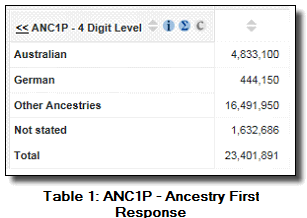
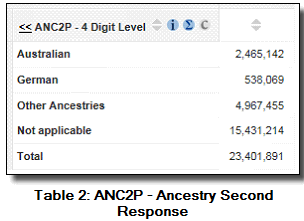
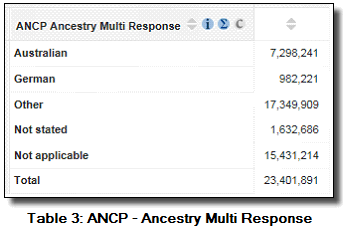
Note that because the Ancestry question asks for up to two ancestries, Not Stated is only relevant to ANC1P – ANC2P is not a required field for those people who provided one ancestry. Instead, Not Applicable is used only for ANC2P, and provides a count of people who did not provide a second ancestry, regardless of if they provided one response or not.
ANCP Multi Response: counting responses or people?
The greatest confusion for users of ancestry data relates to what the Ancestry Multi Response field actually counts. When it is added to a table and all the individual ancestries are summed together, a total count of responses - not people - is produced. This is because each person can provide up to two ancestries. So the total count of responses for all ancestries in Australia exceeds Australia’s total population. However, when using ANCP to look at individual ancestries, the story changes: the count of responses is also the count of people. This is because respondents can only state a particular ancestry once (either as ANC1P or ANC2P).
The tables above help illustrate these differences. While the count of German responses is equal to the count of people who indicated they had German ancestry (982,221), the count of total ancestry responses (25,630,371) – that is, the sum of ‘Australian’, ‘German’ and ‘other’ ancestry categories – exceeds the count of ‘Total’ persons (23,401,891). The reason for this is that while there are 982,221 people with German ancestry, and 7,298,241 people with Australian ancestry, some people will be counted in both categories. These are people with both Australian and German ancestry. This is further inflated by those who are of Australian or German ancestry as well as of ‘Other’ ancestries. The ‘Total’ row counts the total number of PEOPLE who responded, while the other rows count the number of each different RESPONSE – regardless of if they were ANC1P or ANC2P.
The two Other Ancestries codes for ANC1P and ANC2P also do not add up to the same amount as the ANCP Multi Response. This is because any person in this example that provides 2 different ancestries which are neither Australian nor German would only be counted once in this category – it counts the number of people who provided other ancestries, not the number of responses that were other ancestries.
Ancestry combinations
Anyone who reported two ancestries is considered to have a ‘combined ancestry’. Combined ancestries can be examined in the 2016 Census data using TableBuilder and other Census products.
For example, if we want to count the number of people with Australian, New Zealand, or Maori ancestries, the Ancestry Multi Response field will produce these individual counts correctly, as seen in Table 4 below. We know the Total produced is a count of the persons who provided the information in the table. It is not a total of all the numbers above it — that would be a total of responses (and would be equal to 7,648,066).
But if instead we wanted to know how many people reported both Maori and Australian ancestry, or both Australian and New Zealander ancestry, we require a table which cross-tabulates people’s first ancestry response by their second response. as seen in Table 5. By running ANC1P by ANC2P, we can derive the counts of people with ‘combined ancestries’. These tables also produce the number of “sole-identifiers” for each ancestry – these are found in each ancestry’s Not Applicable column.
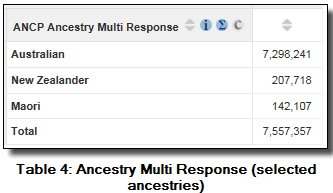
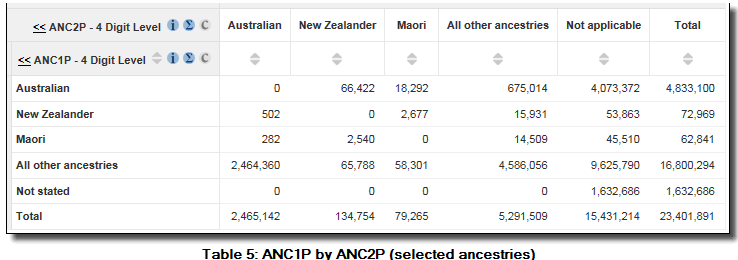
From Table 5, we can tell that there were:
- 45,510 people who stated ‘Maori’ as their only ancestry.
- 81,719 people (15,931 + 65,788) who stated ‘New Zealander’ and another ancestry that was neither Australian nor Maori.
- 4,586,056 people who stated two ancestries - neither of which being Australian, New Zealander, or Maori.
- 13,798,528 (15,431,214 - 1,632,686) people who only stated one ancestry.
- 5,217 people who stated the two ancestries: New Zealander and Maori.
Other Ancestry issues
Subjectivity of Ancestry
Because responses to the ancestry question are based on self-perception, the results must be interpreted with care. While the question successfully captures the ancestry with which people identify, its data is not as robust as that gained from some of the other cultural questions – for instance, country of birth, parents’ birthplace, year of arrival, or language spoken at home. Responses to these questions are not based on perceptions but definitive facts. People can identify with whichever ancestry they like – regardless of their origin – and we can only report on the data collected. It is important to be aware of this.
Analysing ancestry across Census years
The ancestry question was asked in 1986, 2001, 2006, 2011 and 2016. Over time it has experienced changes in both coding and form design.
For instance, between the 2006 and 2011 Censuses, the number of people with Scottish ancestry increased from 1.5 million to around 1.8 million. This did not reflect an influx of Scots to Australia during those five years but was more likely related to
"Scottish" being introduced as one of the tick box options on the Census form during the 2011 Census.
Additionally, as responses are based on self-perception, the data collected is especially sensitive to changes in culture. When comparing ancestry Census data over time, refer to the classification (
ASCCEG), the relevant Census dictionaries, and past Census forms for any changes or issues affecting the specific population in question.
 Print Page
Print Page
 Print All
Print All